rockfish
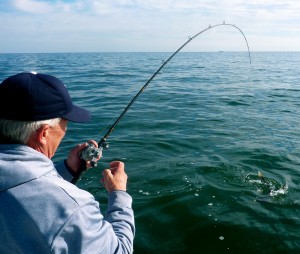 I recently discussed light tackle with some fishing buddies over a bottle of Tennessee’s finest. We all agreed that casting artificial lures on the Chesapeake Bay has the potential to catch as many big fish as any other method. I believe the chances for a trophy striper are better for those who know how to handle a light stick. Until a couple of years ago, most Mid-Atlantic fishermen would have laughed at a statement like that, but not anymore. Throughout 2010, light tackle casting held its own and often out-produced other methods of Chesapeake Bay fishing. It’s encouraging to walk into bait shops and tackle stores now and see Bass Kandy Delights, Bass Assassins, and top water plugs displayed prominently at the end of the aisles beside umbrella rigs and parachute lures. I’m very happy to promote light tackle fishing for one main reason – I don’t know a single light tackle fisherman who isn’t a conservationist. It is absolutely clear that anglers who cast artificial lures are hard-wired to protect the fish and to take care of the water they fish in. Read More!
I recently discussed light tackle with some fishing buddies over a bottle of Tennessee’s finest. We all agreed that casting artificial lures on the Chesapeake Bay has the potential to catch as many big fish as any other method. I believe the chances for a trophy striper are better for those who know how to handle a light stick. Until a couple of years ago, most Mid-Atlantic fishermen would have laughed at a statement like that, but not anymore. Throughout 2010, light tackle casting held its own and often out-produced other methods of Chesapeake Bay fishing. It’s encouraging to walk into bait shops and tackle stores now and see Bass Kandy Delights, Bass Assassins, and top water plugs displayed prominently at the end of the aisles beside umbrella rigs and parachute lures. I’m very happy to promote light tackle fishing for one main reason – I don’t know a single light tackle fisherman who isn’t a conservationist. It is absolutely clear that anglers who cast artificial lures are hard-wired to protect the fish and to take care of the water they fish in. Read More!
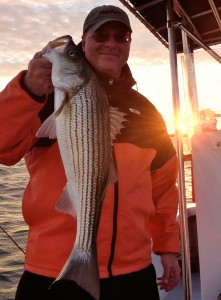 What has been will be again,
What has been will be again,
What has been done will be done again;
There is nothing new under the sun -Ecclesiastes 1:9
Since Candy Thomson published an article about my favorite jigging technique in today’s Baltimore Sun, I thought I might talk about it a little more. First, thanks to Candy for the nice write-up. She had originally planned to fish with us, but unfortunately broke a finger in a kayak accident a couple of days before. She decided to come along anyway and it was great having her, Joe, and Colin on Thunder Road for a fun evening of catching. I’m a big fan of Candy’s Outdoors Girl blog. I don’t always agree with her, but I never miss an entry. There’s no question that, despite the splint she’s wearing lately, she has her finger squarely on the pulse of outdoor issues in Maryland.
I’ll start this article by stating the obvious in that casting artificial lures for stripers using outfits made for freshwater black bass is nothing new – my father taught me to catch stripers using bass lures when I was very young. I had never heard of using heavy duty saltwater trolling gear for rockfish until I moved from Tennessee to Maryland. I was amazed and somewhat amused the first time I saw a twenty-five rod planer board trolling spread. Read More!
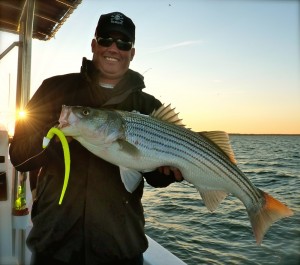 This week I’ve been fishing both north and south of Kent Island. I’m running along the deeper ledges looking for big birds either diving on breaking fish, flying high, or sitting. Since the fall turnover, the better fish have been feeding deep, sometimes thirty five feet deep or more. Once they round up a school of four to six inch bunker, they force them to the surface then explode into them knocking the hapless baitfish into the air where the gulls are waiting. The fish aren’t breaking in big pods but moving around in twenty to thirty fish rat packs. I usually only see a few splashes here and there to send down the birds. The predators move on quickly, so by the time you get to where you saw the splashes, they’re usually gone. The trick to catching them is to figure out what is attracting them to the location and try to anticipate their next move. While migratory stripers will feed wherever they find baitfish, this time of year they’re still running with Chesapeake residents so it’s more likely they are relating to underwater structure. That structure will probably be a live hard bottom near a steep subsurface ledge, especially ledges located near the mouths of tributary rivers. So when big fish are breaking here and there and not really schooled up, the best bet is to simply set up a drift near the ledge and wait for them to come to you. Read More!
This week I’ve been fishing both north and south of Kent Island. I’m running along the deeper ledges looking for big birds either diving on breaking fish, flying high, or sitting. Since the fall turnover, the better fish have been feeding deep, sometimes thirty five feet deep or more. Once they round up a school of four to six inch bunker, they force them to the surface then explode into them knocking the hapless baitfish into the air where the gulls are waiting. The fish aren’t breaking in big pods but moving around in twenty to thirty fish rat packs. I usually only see a few splashes here and there to send down the birds. The predators move on quickly, so by the time you get to where you saw the splashes, they’re usually gone. The trick to catching them is to figure out what is attracting them to the location and try to anticipate their next move. While migratory stripers will feed wherever they find baitfish, this time of year they’re still running with Chesapeake residents so it’s more likely they are relating to underwater structure. That structure will probably be a live hard bottom near a steep subsurface ledge, especially ledges located near the mouths of tributary rivers. So when big fish are breaking here and there and not really schooled up, the best bet is to simply set up a drift near the ledge and wait for them to come to you. Read More!
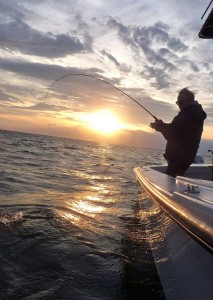 Savvy Chesapeake anglers recognize an event that happens every fall that has significant impact on light tackle fishing. In summer months, the waters in most areas of the Chesapeake Bay stratify so that it is cooler, denser, and saltier down deep, but lighter and fresher near the surface. In the fall, as temperatures cool and strong cold fronts bring lots of wind, the water is stirred up so that the top layer eventually reaches the same density as it is down deep. When that happens the surface water sinks so that for a while, temperatures and salinity are about the same top to bottom. It doesn’t happen all over the Bay at the same time, but it’s easily recognizable to fishermen because we start noticing that fish are feeding at much deeper depths. In some parts of the Maryland portion of the Bay, we are currently experiencing the fall turnover. This can be both good and bad for fishing.
Savvy Chesapeake anglers recognize an event that happens every fall that has significant impact on light tackle fishing. In summer months, the waters in most areas of the Chesapeake Bay stratify so that it is cooler, denser, and saltier down deep, but lighter and fresher near the surface. In the fall, as temperatures cool and strong cold fronts bring lots of wind, the water is stirred up so that the top layer eventually reaches the same density as it is down deep. When that happens the surface water sinks so that for a while, temperatures and salinity are about the same top to bottom. It doesn’t happen all over the Bay at the same time, but it’s easily recognizable to fishermen because we start noticing that fish are feeding at much deeper depths. In some parts of the Maryland portion of the Bay, we are currently experiencing the fall turnover. This can be both good and bad for fishing.
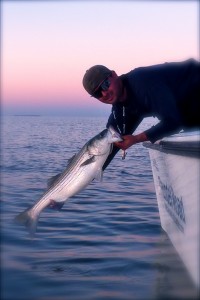 Since I’ve been reporting bigger migratory fish on my recent trips, I’ve been overwhelmed with questions about where the fish are. My apologies if I’ve yet to return a call or answer an email, but the absolute truth is – I don’t know. These big fish are moving around very quickly and they haven’t been at the same place twice. I think we sometimes put too much emphasis on locations, and not enough on patterns. Tell someone where to go to catch a fish and you may help them for a day, but teach them how to identify specific patterns of how fish behave, and you’ve helped them for a lifetime. Ask any good fisherman the secret to repeated success and he’ll tell you it’s the ability to distinguish specific feeding habits. I believe that you can drop a good fisherman into any body of water in the world and he’ll catch fish as long as you give him enough time to establish a prevailing pattern. It’s especially important on the Chesapeake where conditions change quickly and a rapid thirty degree temperature drop in October is not unusual. I think fishing conditions change faster and more often here than anywhere I’ve fished before. Fortunately, fish are usually creatures of habit and there are distinct patterns we can identify in the way they behave. Read More!
Since I’ve been reporting bigger migratory fish on my recent trips, I’ve been overwhelmed with questions about where the fish are. My apologies if I’ve yet to return a call or answer an email, but the absolute truth is – I don’t know. These big fish are moving around very quickly and they haven’t been at the same place twice. I think we sometimes put too much emphasis on locations, and not enough on patterns. Tell someone where to go to catch a fish and you may help them for a day, but teach them how to identify specific patterns of how fish behave, and you’ve helped them for a lifetime. Ask any good fisherman the secret to repeated success and he’ll tell you it’s the ability to distinguish specific feeding habits. I believe that you can drop a good fisherman into any body of water in the world and he’ll catch fish as long as you give him enough time to establish a prevailing pattern. It’s especially important on the Chesapeake where conditions change quickly and a rapid thirty degree temperature drop in October is not unusual. I think fishing conditions change faster and more often here than anywhere I’ve fished before. Fortunately, fish are usually creatures of habit and there are distinct patterns we can identify in the way they behave. Read More!
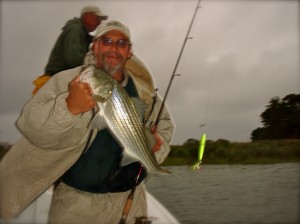 Fall is coming fast to the Chesapeake region bringing changing patterns in fish behavior. This is the time when resident Bay rockfish move shallow and start feeding heavily in order to put on winter weight. While there are still active fish in the open waters over the oyster bars and around the mid-Bay islands, the real fun is close in to the shore; so close in fact that you really don’t need a boat. A kayak or even waders are more appropriate this time of year, the only challenge being access to the best fishing spots. It’s tough to get most center console style fishing boats in tight enough to shore. Many light tackle anglers compromise by going with a bay style boat. That’s a good idea, but since I also fish the big water in the worst of the winter, I prefer a larger ride with a steeper deadrise. Due to the savvy design skills of Eastern Shore boat builder Bill Judge, I feel like I have the best of both worlds. Thunder Road, my 2010 Judge 27 CC only draws about 16 inches. I’ve put all 16 to use and then some over the past couple of weeks while working the grass beds of Talbot and Dorchester counties. Check out the video below and you’ll see what I mean. Read More!
Fall is coming fast to the Chesapeake region bringing changing patterns in fish behavior. This is the time when resident Bay rockfish move shallow and start feeding heavily in order to put on winter weight. While there are still active fish in the open waters over the oyster bars and around the mid-Bay islands, the real fun is close in to the shore; so close in fact that you really don’t need a boat. A kayak or even waders are more appropriate this time of year, the only challenge being access to the best fishing spots. It’s tough to get most center console style fishing boats in tight enough to shore. Many light tackle anglers compromise by going with a bay style boat. That’s a good idea, but since I also fish the big water in the worst of the winter, I prefer a larger ride with a steeper deadrise. Due to the savvy design skills of Eastern Shore boat builder Bill Judge, I feel like I have the best of both worlds. Thunder Road, my 2010 Judge 27 CC only draws about 16 inches. I’ve put all 16 to use and then some over the past couple of weeks while working the grass beds of Talbot and Dorchester counties. Check out the video below and you’ll see what I mean. Read More!


